Welcome to Close Reads! In this series, Leah Schnelbach and their guests dig into the tiny, weird moments of pop culture—from books to theme songs to viral internet hits—that have burrowed into our minds, found rent-stabilized apartments, started community gardens, and refused to be forced out by corporate interests. This time out, Delia Harrington executes a tightly-choreographed dance through the evolution of BTS’ pop hit, “Black Swan.”
At the Grammy Awards on April 3rd, global music phenomenon BTS’s new staging of their billboard-topping song “Butter” blew the audience away. It was easy to feel the excitement in the room even through the TV screen, and host Trevor Noah followed the performance up with an awed and impressed “What was that?!” But those of us familiar with the Korean seven-person band know that this performance, though exceptional, is no exception. If anything, it’s typical of the kind of boundary-pushing, technically exacting, joy-creating performances that BTS fans and those familiar in the industry have come to expect from them.
In truth, I could probably write a Close Read about many of BTS’s stages, and if you look at the Twitter threads, ARMYs (BTS fans) essentially already have. But the one I can’t stop thinking about is “Black Swan.” “Black Swan” manages to both be typical of BTS—in that it’s creative, high-concept, well executed, and stunning to watch—while also managing to stand out even among their stages. It’s ambitious in scope, even for them, and marks a departure from their more usual hip hop-related dance styles, with elements of popping and locking and b-boying. All of which fittingly ties back into the themes of the lyrics themselves.
Written by group leader RM, longtime BTS producer Pdogg, Filipino-Canadian musician/songwriter August Rigo, as well as Vince Nantes and Clyde Kelly, “Black Swan” the song was inspired by the 2010 Darren Aronofsky film of the same name and, in turn, the ballet Swan Lake. In the film, a ballerina performing Swan Lake is tormented by her visions of a dark version of herself as she squares off against a rival, her understudy, who aims to replace her. During a livestream with fans, RM shared that he rewatched the film to write the song, saying he cried several times throughout the process. According to Pdogg, the song reflects the emotions the members were feeling when it was written.
The lead single off the album Map of the Soul: 7, “Black Swan” was released on January 17, 2020. The emotionally spare, trap-inspired hip hop song is about the tragedy of an artist falling out of love with their art. RM said he “wrote the lyrics imagining how the life of a dancer could be.” According to the band’s description of the song on Spotify, “The song lends voice to the band’s darkest fears—the music they do will one day cease to touch or move them. Yet, every time they come face to face with this “Black swan” within themselves, they hear voices calling out from deep within their hearts and are stricken with the realization that music is all they have. This track is a confession of an artist who has truly learned what music means to himself.”
Bringing their audience into such a deeply personal fear is standard for Bangtan, who have made it a point to comfort their fans by sharing their own human struggles. Still, that makes it no less powerful for them to share such a vulnerable fear when they’re at the top of their game, especially one that deals so directly with their ability to continue their careers. There’s something wonderfully recursive about “Black Swan,” a beautiful work of art about what it feels like to fall out of love with your art. Live performance is a living, breathing thing, and “Black Swan” has taken on several different forms throughout its life so far.
Black Swan Art Film
With “Black Swan,” BTS and their label, Big Hit Entertainment (now Big Hit Music), took a novel approach for the song’s rollout, commissioning an art film performed by the MN Dance Company of Slovenia. (The media took note.) Seemingly filmed in an abandoned shopping mall, the film provides haunting visuals to accompany the song and set the tone for the performances to follow. The film opens with a quote from the famed choreographer Martha Graham: “A dancer dies twice—once when they stop dancing, and this first death is the more painful.” This quote is a theme throughout “Black Swan,” with lyrics rapped by both members Suga and RM referring to dying the persona’s first death.
The film is set to a version of the song that includes string-heavy orchestration (including the gayageum, a traditional Korean instrument in the zither family), adding to the artistic sensibility of the short film. In it, seven dancers dressed in black—one, shirtless, is the black swan—tell the emotional story of the song. The six, fully clothed dancers are at turns the swan’s inner demons, his tormentors, his prison, and eventually, his wings, as they knock him down, tread on him, chase him, and keep him inside a cage made of beams of light.
Briefly, the black swan attempts to leave his demons behind, separating himself from the other dancers, seemingly packing his bird-like motions away during a decrescendo of the string section. He walks as a human might, as if to exit the mall, in near-silence. But just as artists like BTS cannot separate themselves from their fears, the music returns full-throated, as do the dancers. This time, the black swan calmly accepts the darkness inherent in his nature. He returns to bird-like movements, introducing both a literal and figurative inversion and commanding the other dancers rather than being consumed by them. Once his tormentors and inner demons, the other dancers now become his wings, helping him mount to the sky.
“Black Swan” Music Video
The song’s music video, directed by frequent BTS collaborator Lumpens, takes place in the Los Angeles Theatre and depicts the members as having a shadow within them, fighting perhaps to escape or take over. That all plays into the overall Jungian concepts that the band plays with throughout the album. Jimin, who went to Busan Performing Arts High School where he trained in contemporary dance, has a moving dance solo and creates the shadows for his fellow members Suga and Jungkook, with lead dancer J-Hope dancing the part of the shadow for RM, who is closer to his height.
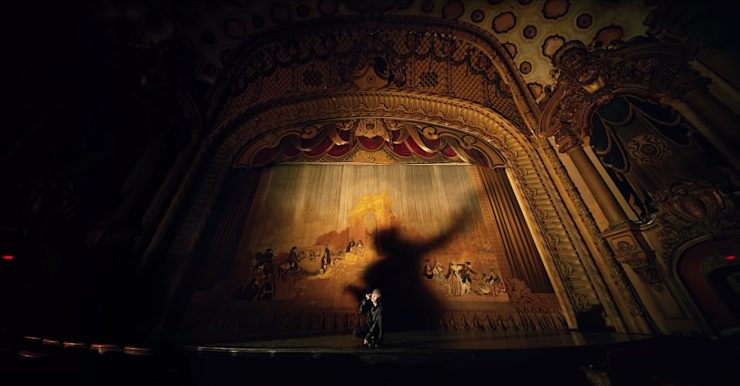
The members have referred to Jimin as their Black Swan, and beyond him sprouting wings in this music video, across the various iterations of the song, it’s not hard to see why. The members are turning in excellent performances while largely working outside of their comfort zones in terms of dance style, but it’s Jimin who leads them. He not only takes on more involved choreography for solos or his unit dance with Jungkook, he infuses his movements with emotion to tell the story. Thematically speaking, he physically brings to life the shadows that represent the black swan within the other members that keeps threatening to escape.
Choreography
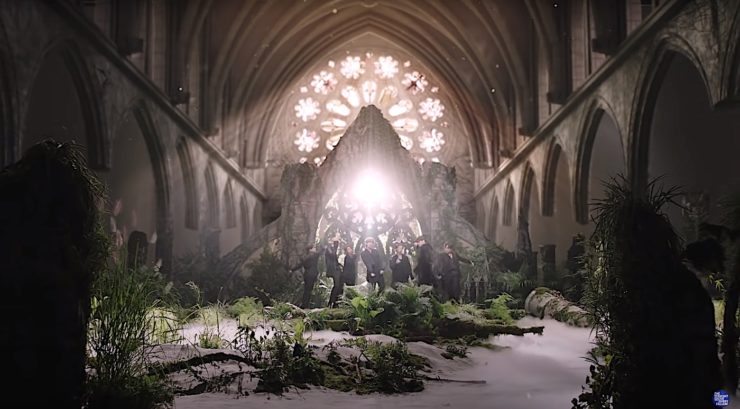
Watching these performances, any limiting notions of what it means to be a pop star, or indeed the concept of genre generally, go out the window. The “Black Swan” stages have more in common with ballet, contemporary dance, and performance art than with the Western conception of boy bands or pop music as a whole. That said, wouldn’t it be a wonderful thing to allow BTS’s achievements to broaden the arena for boy bands, rather than using them to do a boy band twist on the old “she’s not like the other girls” backhanded compliment? To see BTS perform “Black Swan,” one cannot help but broaden the scope of understanding of what is possible for pop stars. And considering media-hopping talents like Lady Gaga and creative work like Beyonce’s Lemonade and Homecoming, perhaps the thing that limits pop is the expectations imposed upon it, rather than the abilities of the people who create it.
The “Black Swan” choreography reinforces the song’s message, their bodies at times undulating like the flow of water that a swan would inhabit. At other times, the members take on stilted, bird-like postures, moving as though their joints are being pulled awkwardly by some outside force, like an avant-garde take on the old marionettes-on-strings dance. When RM sings in Korean, “If this can no longer make my heart flutter/Perhaps, this will be how I die once,” he runs a thumb across his neck, in a gesture for death. The members’ bodies pulse to the jump, jump, jump and bump, bump, bump of the heartbeat the lyrics describe, and there are a few key moments where members appear to square off lyrically and choreographically, highlighting the theme of the self battling the shadow self. It’s unclear if the hand one member offers the other is a help or a challenge, but perhaps that is the point.
The Late Late Show with James Corden
https://www.youtube.com/watch?v=wSNd02kVv8o
In January of 2020, BTS performed “Black Swan” on television for the first time, on The Late Late Show with James Corden. While smaller in scope than some other future performances due to the physical size of the stage and the length of time afforded to the performance, it is no less impressive. BTS performed barefoot as they did in the music video, an unusual occurrence for the band that warranted specific practice. According to Jimin, though, it suits the artistic sensibility. He told WeVerse magazine, “I think it’s got to be barefoot when I’m doing a classic-style dance. It looks sharp and attractive when I wear dress shoes, but it always feels more natural to express myself barefoot. It’s more dynamic, I guess you could say.”
The set is made to look like Bangtan is dancing along the surface of a lake within a dark and dreamy blue-tinged forest, the kind of setting where something a bit dark and mystical might happen. BTS was thankfully able to perform on Korean television as well, on M Countdown, Inkigayo, and MusicBank, before the pandemic would rob them of the chance to perform the song before a live audience again for several years. During the pandemic, they also gave a number of virtual performances of “Black Swan,” including on The Tonight Show as part of a week-long residency.
Melon Music Awards
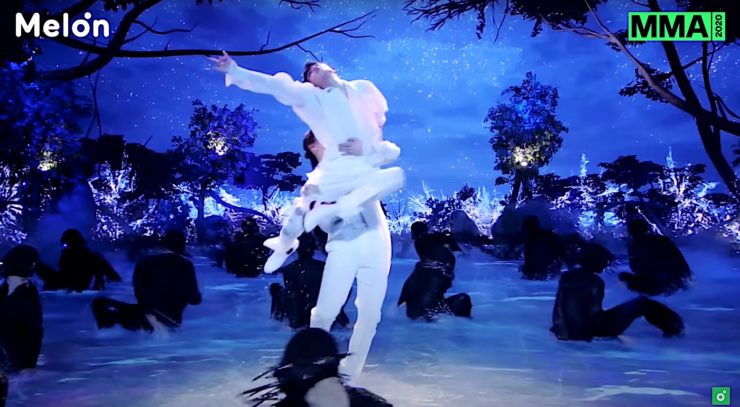
In December of 2020, BTS brought a stunning set of stages to Korea’s MMAs, or Melon Music Awards. The entirety is well worth the watch, but even among them, “Black Swan” stands out. Here, BTS uses the purely orchestral, instrumental version of the song, without the original song with singing and beats layered underneath as it was in the interpretive dance art film. This allows Bangtan to make full use of the classical tone and emotionality of the string arrangement to offer up a sweeping balletic number to show a different side of themselves.
This time, the lake is not simulated or suggested. Clad in head-to-toe white (and later black), the members dance in water, surrounded by dozens of other dancers swirling, circling, tumbling, and lifting them. Bangtan is known for their choreography, and they’ve had their creative lifts since the start of their history, but nothing like this. Dancing in pairs, the members repeatedly leap past one another, lift and fling each other, demonstrating what must surely be an unprecedented level of modern dance skills and sensibility in the pop music landscape. The water element increases the artistry but also the difficulty and the danger of the performance, and likely the preparation time necessary.
It’s a spectacle that bears understanding from the inside out, and the dance practice and behind the scenes videos are available to help with that. The pure mechanics of who goes when feels like a magic trick on its own, before even considering the lifts. It’s the kind of performance that shows how BTS did their best to take the pandemic in stride and reframe what others saw as disadvantages into opportunities. Instead of lamenting not being able to perform live at awards shows, BTS and their team, led by Performance Director Son Sungdeuk, created unique stages that could only happen if they were created and recorded in advance somewhere else, whether that meant dancing in a few inches of water and doing a wardrobe change part way through, or performing at various Korean landmarks of cultural and historic importance.
The only blemish is that Suga, who was recovering from shoulder surgery, was not part of the performance. It’s a huge loss, and in other performances during his absence (including from this same awards show), one can more easily see the literal open space in the choreography where he belongs, and the way that BTS’s line-up is truly meant to be seven.
Permission to Dance on Stage
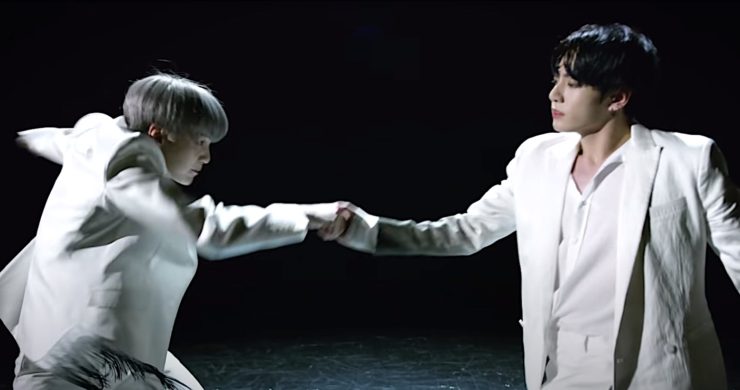
Thankfully, in 2021, BTS was able to once again perform in front of live audiences, and songs like “Black Swan,” “ON,” and “Dynamite” have finally gotten their due. “Black Swan” has been a key part of the Permission to Dance on Stage shows in Los Angeles, Seoul, and Las Vegas, transitioning seamlessly from another powerful song, “Blue & Grey.”
Here, BTS uses “Black Swan” as two separate tracks—first a rousing, sweeping take on the orchestral version, then the regular version—instead of layered as they were in the interpretive dance art film. This allows time for Bangtan to put on a lush modern dance performance before going into the full choreo that they performed on the Late Late Show and other typical television appearances.
Taking some of the best elements from every prior performance, this concert performance iteration of “Black Swan” is probably the best example I’ve ever seen of art made on a stadium-level scale. Dancers spill across the stage wearing oversized white-winged sleeves that flap and flutter, equally part of the soundscape and choreography. Each member has a showcase moment as the head of the large black swan, the rest of the performers undulating as everyone on stage acts as one, like a school of fish moving as a group to create a larger being. Large screens behind the members and on the very stage they walk add to the performance, and feathers fill the air. Like in so many of their performances, the group is unified in black, but each outfit is distinctly their own, with textures like lace, mesh, ruffles, and sequins that can be seen from afar make up the blazers, blouses, slacks and a skirt that Bangtan wear.
I sat in vastly different locations each night of the LA shows and each was a unique experience. I saw the performance from above, different sides, head on, picking up new details each time. From different vantage points, I could see how the dancers filed in, where the various members hid within the mass of people while they awaited their time to shine. Fans on the floor could certainly see faces better, but from above, I saw the shape of the entire bird they collectively made. From the sides, suddenly the tableaus the dancers created when each member had their moment revealed themselves. Closer up, it’s easier to see the moves and costumes of the individual dancers, but farther away, those same motions play out like a domino effect, revealing to the naked eye the full story and spectacle behind what is only glimpsed on screen. Watching “Black Swan,” both viewings are rewarded.
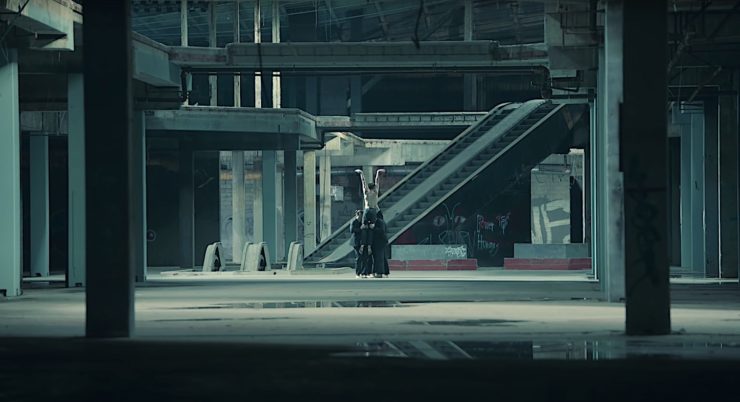
Standing perhaps in contrast, or maybe even as a coda to the meaning of “Black Swan,” these varying performances, each meaningful in their own way, represent BTS pushing themselves creatively, as musicians, dancers, performers, and artists. Pouring their emotions into their work, training in a different style of dance than most of them were used to, and putting in whatever time was necessary to ensure they could carry out these beautiful performances safely. From the outside perspective, growing creatively seems to be the very thing keeping Bangtan fulfilled by their art a decade on as a group, well past the cursed seventh year in K-pop or misguided Western notions of someone breaking up the band to go solo.
The “Black Swan” performances represent BTS acknowledging their deepest fears and choosing instead to use those fears to grow creatively. Borrowing heavily from modern dance, they create an artistic spectacle that’s so beautiful it demands the audience hold their breath, if only for a moment.
Delia Harrington has been a freelance writer since 2013. They specialize in the intersection of politics, pop culture, and gender. You can find their work at sites including Den of Geek and The Mary Sue, and find them on Twitter at @DeliaMary










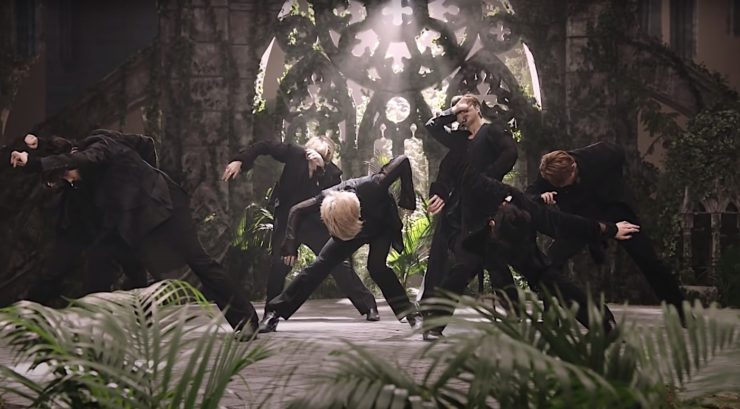
THANK YOU.
On behalf of all ARMYs, I want to thank you for the thoughtfulness put into this article. It articulated feelings associated with Black Swan that are difficult to put to words; it elaborated on the depth of BTS’s music, messages, and hard work to a point rarely met by other North American writers; and it renewed my hope in American journalists–that there are still people who can do justice to the seven boys we love so much and the art that they create.
Additionally, you didn’t take away, try to cover, or even downplay the unique, Korean elements that make them who they are.
Keep up the good work! 수고하셨습니다!
This song and the performances accompanying it deserved this kind of a write-up I’m so thankful we got to read this
I’m so thankful we got to read this
Muchas gracias por el artículo, me encantó tu redacción, hasta me hiciste conocer algunas cosas que no sabía de Black Swan. Tu manera de describir todo me hace recordar el porque soy Army ya que me encantan sus presentaciones, su música, sus letras, su pasión, su entrega y sobre todo las personalidades de ellos.
Gracias por tomarte el tiempo de hacer una crítica como corresponde sin querer llamar la atención con contenidos falsos.
This is one of the best article I’ve ever read which primarily focuses on BTS’ Art which is hella underated… After reading this I got to know so much more about the choreography part of the song… Thank you for your genuine effort and interest….
An absolutely incredible breakdown of what I consider to be Bangtan’s best song.
Wow! What an in-depth and fascinating article. It’s so nice to see someone in the media truly appreciate the artistry and talent of BTS. Black Swan is a favorite of many Army members. Thank you for writing this. You may want to check out another of their more theatrical MVs – Blood, Sweat and Tears. I think you would find it fascinating as well. In case you don’t know, the purple hearts are something Army attaches when we appreciate or love something. So here are a few more!






I’m so thankful for this article, it unfolds such an amazing perspective from a great writer who is acknowledging the artistic talent of a wold star “our beloved group BTS”, that is somehow still underrated especially to the western art industry.
Thank you for the insightful write up here. While my Kpop center is Mamamoo (armies should check Solar’s solo cover of Fire if your not familiar) I’ve loved how BTS has just taken over the world. There are a number of Kpop groups who are doing things that SF/F fans would appreciate. I’d especially point out Dream Catcher’s Dystopia trilogy (Scream, Boca, Odd Eye).
If every article on the web was constructed this thoroughly, the world’s reading comprehension would be edified. Period
Black Swan was my gateway to the Bangtan rabbit hole. I saw them that cold January night at the James Corden show and my life was profoundly altered. Simply put, they literally took my breath away, I was dumbfounded, astounded and confounded… who, what, how could this group of young men…? I have been in this journey of wonder-full discovery ever since. Every single performance that they do of Black Swan reinforces that my faith was not for naught. I saw them in LA as well from two different vantage points, so I certainly know what you are talking about. It remains my absolutely favourite number of the PTD concert. Thank you, thank you for eloquently articulating what I could not. You are very much appreciated. I only wish we could have more of you. Salut!
Credit must also be given to the choreographer of the Black Swan performance…Sergio Reis
This was a beautiful, almost forensic analysis of one of my favourite BTS events. Black Swan altered the trajectory of my life and work, and I’m so glad. Thanks for giving this masterpiece the art history treatment it deserves.
As a fandom, we’ve sadly come to expect so much less when writers talk about Bangtan. Articles full of backhanded compliments smeared with racist, xenophobic undertones are the norm and attempts to view openly are limited by their closed minds.
To come across such a beautifully written article is a much needed rarity. You took in all of the nuances from their different performances and formed an opinion without prejudice. They are such incredible musicians, performers, dancers, singers, beautiful human beings and so much more. It fills my heart with joy when someone views them without bias and discovers the beauty and multifaceted artistry of Bangtan. Thank you.
Great article! I’ve read so many articles from Billboard, Rolling Stone, etc etc and they really haven’t grasped the nuances and layers of what BTS has been doing as well as this article did. Thank you for taking the time to research them properly. Having grown up with western artists, my mind was completely blown when I got in to BTS and realised the scope and pure genius of their catalogue of work. I hope more people come to recognise and appreciate BTS for the art that they’re contributing to the world.
Enjoyed this thoroughly!
Couldn’t agree more on the part about watching these performances at SoFi stadium from different points of view – a truly mesmerizing experience!
My first viewing of their Black Swan performance in 2020 made me ARMY for life! 3 PTD concerts later at SOFI and LV, it is still my favorite performance…….so moving and haunting. Now knowing more about BS, makes me love BTS even more. Thank you for the insightful and truly thoughtful article.






What an extraordinary piece of writing!
This was posted in an Army Facebook group I belong to, but I was not expecting this level of excellence.
This is art, just as much as the work of BTS is.
I would like to wish that every article on the Internet was built so carefully, the understanding of reading in the world would be instructive. Thanks to the author and publishers of this article. BTS forever!






Absolutely love this article. Beautifully written, thank you
Thank you for this, touching on all of the parts: these seven talented and hard-working guys, the songwriters, the choreographers, the stage design…. Their artistry is amazing. Their 2018 performance of Idol at the MMAs is a must-see, as they incorporated traditional Korean culture into it —it has a beautiful intro. For a much simpler performance, the choreography in Let Go is lovely.
What a wonderful analysis of this amazing song!
I discovered BTS on February 24, 2020 on the Jimmy Fallon show when they performed their new song “On” at Grand Central Station in New York City. I had never heard of them before. I was overwhelmed with their exciting and creative production. I was shocked with their stunningly exquisite delivery of precise choreography. Their raw explosive talent was almost unbelievable. I was compelled to investigate who they were and everything about them. So from that day forward I have watched BTS content on YouTube everyday. I discovered they were not typical K-Pop idols. To my delight I found them singing and performing a variety of genres. And “Black Swan” is in a class of its own. This masterpiece must be watched many times over to understand its complexity. It shines with such beautiful artistry and imagery. “The boys” captured my heart and soul with their powerful and emotional portrayal through dance of this famous story. I was awed to say the least. Your eloquent exploration into BTS’s thought provoking performance of “Black Swan” elevates the group to its rightful place of world wide appreciation. I challenge those of you who have never experienced them despite your age or your love for specific genres of music to take time to watch their art work. They do it all. And they do it all so very well. Thank you for your beautifully written article. I enjoyed it so much. Carry on with your journey to discover their genius and share with us their gems they gift to all of us. Happy travels.